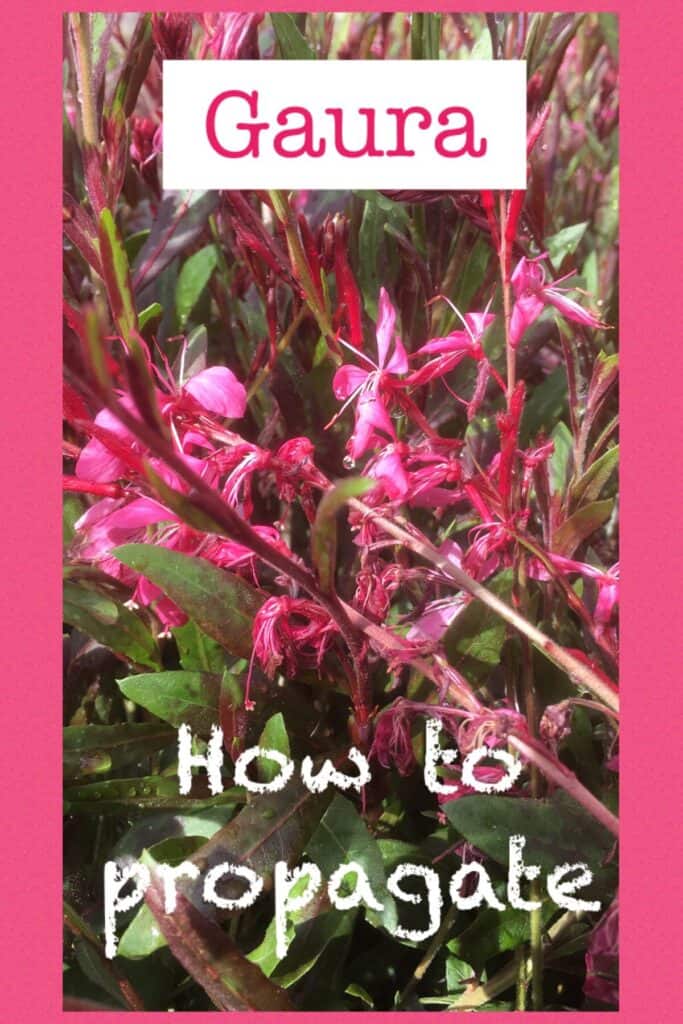
How to propagate Gaura lindheimeri (butterfly bush)
Gaura lindheimeri (butterfly bush or bees blossom) is a very easy plant to propagate. We use cuttings as our preferred method and can usually produce a viable plant from a cutting within 3 months.
Gaura’s will also self seed, however the seed will not always be true to the parent plant. The method outlined below can be used on any specially bred variety of gaura lindheimeri.
Though if you plan on selling your plants, you will need to make sure you are not taking cuttings from a new or ‘PBR” plant variety, as these are prohibited for reproduction without permission,
The cuttings below were taken in late autumn and were ready in late winter. Success rate was over 90%.
Select a plant
There are many different variations of gaura lindheimeri currently available. As mentioned, this method will work on all of them, so select the variety which most suits your preferences and location.
Because a cutting is a clone of the mother plant, select a strong vigorous plant free from pests and diseases. Also worth noting is that some gaura’s don’t hold their colour well, so select cuttings from a plant that is a proven performer.
We like to cut the plant close to the base near the centre of the plant. The best cuttings for gaura are base cuttings. Use stems that are still green but low enough down the stem that they are quite firm. Avoid taking cuttings near the top, as each stem is a flower spike.
Cuttings taken near the top will still work but they tend to take longer and don’t provide a plant that is as bushy.
When creating the cutting, cut the stem below a leaf join, this is called a node. Then cut the stem above the next leaf. Strip away the bottom leaf leaving a scar where the leaf was (as shown below) the roots will sprout from here. Cut the leaf on top in half (as shown in the picture below).
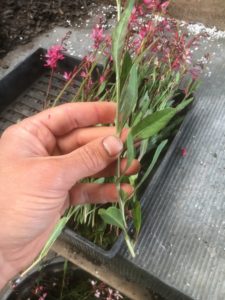
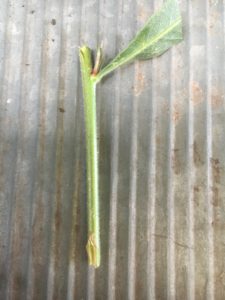
Striking the roots
To strike (grow roots) the cuttings, we use a perlite peat moss mix. Both are excellent at retaining moisture and providing a sterile growing environment. Our mix is 90% perlite to 10% peat moss.
If you are using cuttings from the base of the stem, you should be able to simply push the cuttings into the mix, without the need to create a hole or draw a line. It’s a good idea to water the mix first to firm it up. When the mix is dry the cuttings do not hold in place well.
Once all your cuttings are in the mix, water thoroughly. As the cuttings have no roots at this stage they must be kept moist.
Check the perlite peat moss mix daily, if it has moisture in it you are fine. If you notice it getting a little dry on top, give it a light watering.
Also the cuttings must be kept in an area out of direct sunlight and wind. These elements will quickly dry out the cuttings.
It should only take about 2 months for the cuttings to develop roots. 3 months at the most.
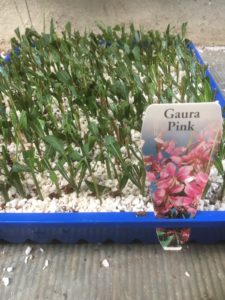
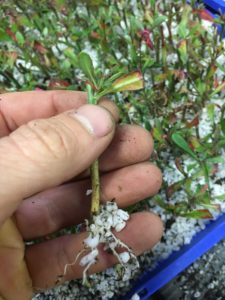
Potting the cuttings
Once our cuttings have roots we can pot them up. We choose to pot our cuttings into 2″(50mm) pots. These smaller pots allow us to use up less valuable space within the nursery, but still provide a great root system for our new plants.
Whenever potting plants into any sized container, I recommend using a premium quality potting mix. The mix should contain trace elements, vitamins and minerals that will ensure your new plants get a great start.
Plants that are lush and healthy are generally less susceptible to pests and diseases.
We almost always use a seaweed based fertiliser on our freshly potted plants. This greatly speeds up the root and overall plant growth. We water the plants in with this solution after they have intially been potted, and then again 2 weeks later.
Whichever you choose, ensure you water the freshly potted plants until water runs freely out from the drainage holes of the pots.
The plants need to be stored in a sheltered area whilst we wait for the root system to develop further, and the plant to grow. This is another reason why it is handy to pot into smaller pots, as they take up less room in our greenhouse.
Once the plants have developed a root system that reaches the edges of the pot and are emerging from the drainage holes, they can be moved outside and potted into larger pots or the garden.
We hope this guide has been helpful and you feel confident in your ability to now propagate your own gaura lindheimeri (butterfly bush). Below is a short video showing the above steps.
If you enjoyed please subscribe below and we will continue to show different plants we propagate.
CLICK HERE TO SEE OTHER PLANTS WE PROPAGATE
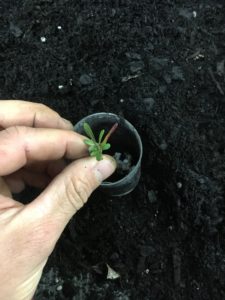
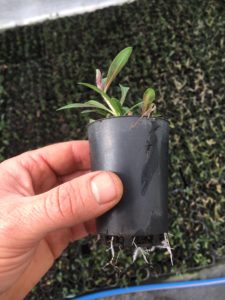
Propagation Kit
We have also put together a resource page that contains links to the products we use or similar. If you want to check that out click the link.
Propagate Gaura lindheimeri (butterfly bush) Video
Gaura lindheimeri – butterfly bush pink. Information & Care
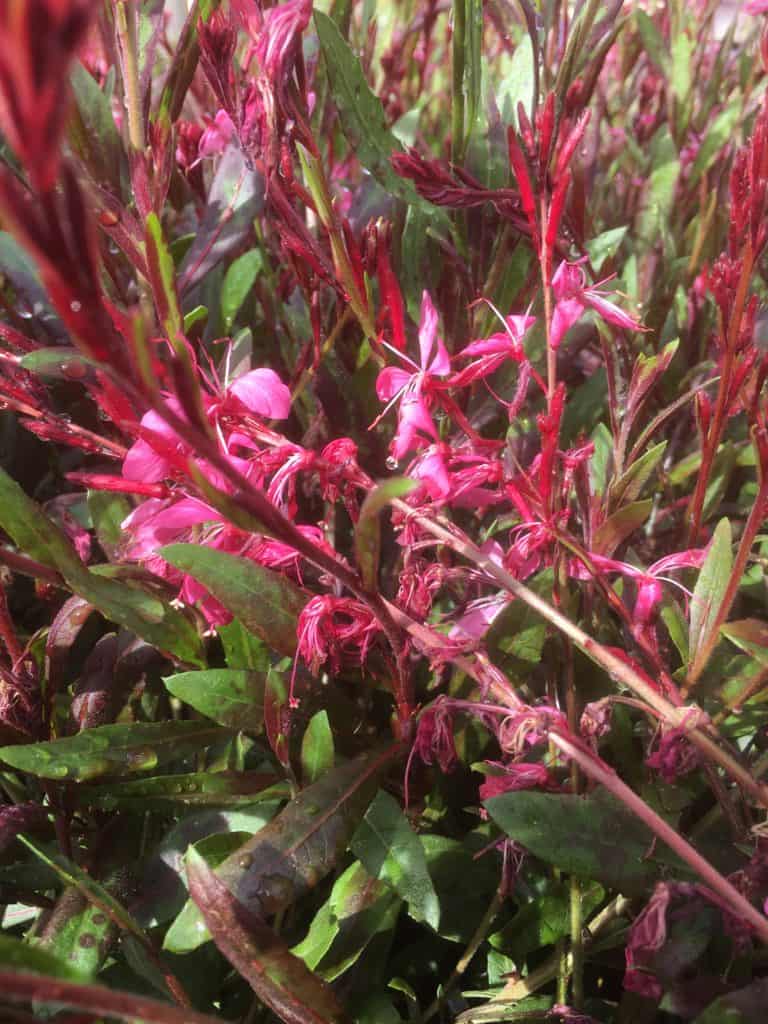
Gaura lindheimeri – butterfly bush pink is a fast growing perennial shrub. Foliage is green with reddish hues. Produces long dainty flower spikes covered in small pink flowers during the warmer months.
A great plant choice for cottage gardens or just adding pops of colour. Wonderful choice for bringing in the bees and butterflies. Even throughout winter it can be quite showy as the foliage tends to go almost completely red.
Does well in a wide range of soils. Responds very well to hard pruning, prune in winter and summer for best flowering. Tolerates light frosts. Will also withstand periods of dryness.
Cultural Notes
Botanical name: Gaura lindheimeri – pink
Common name: Pink butterfly bush, beeblossom
Family: Onagraceae
Native to: Southern USA
Flowers: Spring-Autumn
Position: Full sun/part shade
Height: Foliage 50cm Flowers 1m
Width: 50-70cm
